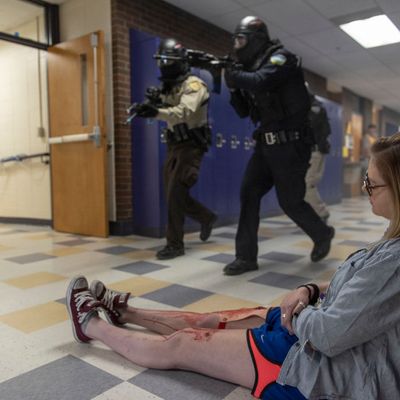
For educators, school-shooter drills have become a grim ritual. But teachers at Meadowlawn Elementary School in Monticello, Indiana, say one recent drill went much too far. As reported by the Indianapolis Star, law-enforcement officers lined teachers up and then shot them execution-style with an airsoft rifle. Pellets left bloody welts and caused panic; teachers had not been warned that officers would use a training weapon during the drill. “They told us, ‘This is what happens if you just cower and do nothing,’” one anonymous teacher told the Star. “They shot all of us across our backs. I was hit four times. It hurt so bad.”
White County Sheriff Bill Brooks, whose department conducted the training, says that his officers stopped using the rifle after they were “made aware that one teacher was upset.” But multiple teachers complained to the Star, and the state’s largest teachers union, the Indiana State Teachers Association, has asked legislators to amend a pending school-safety bill so that it would prohibit safety-drill instructors from launching projectiles at teachers. During a Wednesday hearing, ISTA members vividly described hearing screams from shot teachers:
Brooks opposes the amendment. “We don’t need legislation in White County,” he told the Star. “We’re just not going to do it.” But Keith Gambill, the vice-president of ISTA and a music teacher based in Evansville, Indiana, told New York on Thursday that the union remains committed to legislative change anyway. “We want employees and students to be in a safe environment even if there has to be a training,” he said. “But the training should not involve shooting a projectile.” Gambill said the union had not received reports of similar incidents at other schools.
But while the Meadowlawn case is unusual, it has a legible genealogy. The sheriff’s intransigence, the drill’s traumatic conclusion, even the simple existence of the drill, all stem from the same basic reality — America refuses to pass any meaningful gun-control legislation. There’s no point, legislators say. Mass shooters are evil, and no law can strip evil from the hearts of men. And so mass shootings become symptoms of something other than legislative malpractice. They become sins, or “a random force of nature,” as the writer Patrick Blanchfield once put it. We can’t prevent mass shootings, this logic insists, so we can only prepare for them. As Blanchfield noted, the proliferation of gun violence has spawned a lucrative cottage industry — bulletproof whiteboards and bulletproof backpacks and training programs that script extreme school-shooting drills.
There are multiple reasons for this state of affairs. Liberals look at New Zealand, which banned military-grade guns within ten days of the Christchurch shootings, and draw up a short list of reasons to explain why they acted, and we do not: American gun culture, the particularities of our legislative system. But our intransigence is not just about our political system or some buried nostalgia for a mythical cowboy past: it is also about money. Guns make certain people very rich — people like gun manufacturers and gun lobbyists, though they aren’t the only beneficiaries of America’s reluctance to restrict its firearms.
The White County Sheriff’s Department shot teachers during an exercise designed by the for-profit ALICE Training Institute. The Ohio-based, for-profit organization did not return emailed requests for comment before press time, but its website is instructive. Though there’s no evidence that it has encouraged law-enforcement officials to assault teachers with pellet guns during trainings, it does promote a proactive response to active shooters. Each letter in its name corresponds to a different step in its safety protocol. “ALERT is when you become aware of a threat,” it says on its website. After educators become alert to whatever armed horror awaits, ALICE recommends that they go on lockdown, and barricade themselves in a room. “I” is for inform; at this point, educators are supposed to communicate their danger to their co-workers and the authorities. And then it’s time to counter — to distract and divert — if they cannot evacuate themselves and their students.
ALICE even released a children’s book, called I’m Not Scared, I’m Prepared. A YouTube video purportedly shows the book’s contents. In it, a class of children learns to distinguish between “sheep,” “shepherd,” and “wolf”; they are the sheep, the teacher is the shepherd, and the shooter is the wolf. Children learn to throw wadded-up paper balls at a pretend antagonist before zigzagging down a hallway to safety.
The White County Sheriff’s Department seems to have improvised, violently, on the institute’s training templates. But even so, they only pulled from existing riffs. ALICE operates within a thriving market, as The Atlantic reported in 2015. School systems can choose from a variety of curricula and training programs, produced by competing, acronym-laden groups. Simulated shootings are becoming common, and are billed, always, as safety drills. They are often elaborate affairs, complete with fake blood and fake victims; at one Missouri school profiled by NBC News, drama students received extra credit for their participation. Though a growing body of evidence suggests that shooter drills can traumatize children, some states now require schools to conduct them, and a lack of congressional action on gun control guarantees future demand for the programs.
It’s not clear, exactly, how paper balls would have stopped Adam Lanza at Sandy Hook Elementary School. But lawmakers leave educators — and students — few other options. As disturbing as ALICE’s material may seem, it merely profits off a problem created by other people. Lawmakers have displaced the burden of public safety onto educators and even children, who now learn to assess risk while they’re still learning how to read. Meadowlawn is a paroxysm; underneath it, there is inertia. We rehearse the coming trauma because we cannot stop it. When the wolf knocks down our door, at least we’ll die on our feet.






























